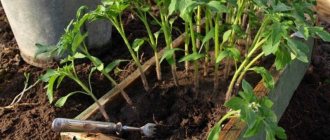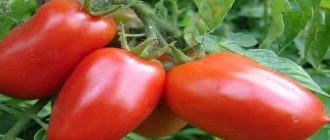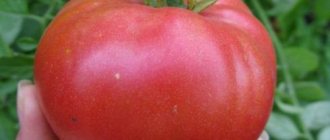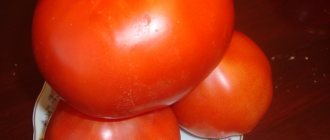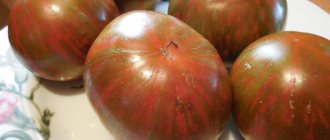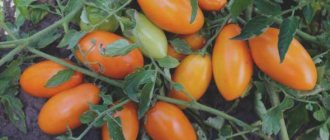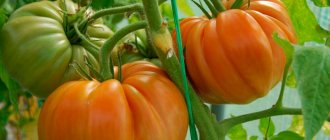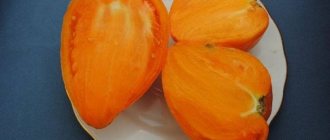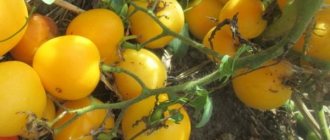Lovers of large-fruited tomatoes can rejoice - there is an excellent tomato for them, the Giant of the Moscow Region. It is a super-yielding variety. The beautiful heart-shaped fruits have a delicious taste.
| Height | Landing location | Ripening time | Fruit color | Fruit size | Origin | Fruit shape |
| Tall | Greenhouse, Open ground | Mid-season | Reds | Large | Variety | Heart-shaped |
Characteristics of the variety
The “Giant of the Moscow Region” tomato is a representative of large-fruited plants with excellent taste characteristics and properties for storage and transportation. Description of the tomato “Giant of the Moscow Region” :
- indeterminate tall bush (up to 2.5 meters) strong, spreading;
- foliage is average;
- mid-season;
- the weight of one tomato can reach 800 g, on average - 400-600 g;
- yield - 8-12 kg per 1 square meter (i.e. from 2 bushes);
- fruits are fleshy, juicy, sugary;
- the shape is heart-shaped, when fully ripe the color of the fruit is red;
- taste with delicate sourness and sweetish aftertaste;
- The dense skin ensures the absence of cracks and deformation during storage and transportation.
The advantages of the “Giant of the Moscow Region” variety are its productivity and extended fruiting - when sowing seeds in March, the fruits can be enjoyed until late autumn. High resistance to adverse factors and good immunity are achieved through plant selection, which reduces the need to use various chemicals.
The downside is the shelf life - after full ripening, the harvested fruits are stored for no more than three weeks. The duration of freshness can be increased by harvesting a technically ripe crop, which is stored in storage for ripening. This procedure does not affect the taste.
Rules of care
The plant does not require total control. It only needs moderate soil moisture, garters and the addition of nutrients.
Rules for caring for seedlings
Features of care:
- regular loosening carried out after watering;
- timely removal of weeds;
- pinching of a plant - breakage of lateral shoots from the leaf axil;
- moderate watering - no more than 12 liters per day;
- irrigation is carried out at sunset to prevent burning of the leaf surface;
- Garters are required.
Gardeners planting Siberian giant tomatoes share photos and reviews about the yield. Characteristics and reviews make it possible to get a complete picture of the characteristics of the variety.
Features of cultivation
“Giant of the Moscow Region” can be grown both in open ground (in the southern regions) and in greenhouses. For the middle zone, greenhouse sowing is recommended, which can be started throughout March; if you are late with the deadline, the harvest may not be so large.
Before planting in the ground, the tomato is sown as seedlings (45 or 60 days in advance, depending on the light), after which it is planted maintaining a 40-50 cm distance between plants.
Each stem requires a mandatory garter, since the fruits are very large and heavy. Pinching is required to form 1-2 stems, as well as limiting growth, especially in a greenhouse. Tomato responds well to fertilizing:
- the phosphorus-potassium mixture is applied 2 weeks after planting in the ground;
- bloodworm with the addition of potassium sulfate (1:10) is used for flowering and ovary;
- wood ash diluted in water has a good effect on the plant during the period of fruit formation;
- a solution of superphosphate and humate is recommended at the ripening stage.
With proper care, ripening occurs in 11-12 weeks.
Landing Features
The Siberian giant tomato is recommended to be grown in seedlings. Sowing is carried out 60-65 days before planting in the soil. Before placing the seeds in the ground, they must be treated in a solution of potassium permanganate and a growth stimulant. Then they are planted in containers with prepared soil, deepening them by 1.5 cm.
Landing Features
Preparing soil and seedlings:
- Moisten the soil with warm water using a sprinkler.
- Plant the seeds, cover the containers with film and leave until the first shoots appear.
- After 2 leaves appear, place the shoots in separate containers. To preserve the roots when replanting, it is necessary to use peat pots.
- Maintain a distance of 50 cm between sprouts so that they do not interfere with each other during development.
- Fertilizers for growth are applied to the holes as top dressing before planting. Additional microelements are added during the development of bushes. It is appropriate to use natural fertilizers.
- The bushes are tied to a support, the leaves are removed from the bottom of the stem.
- The upper area of the stem is pinched.
The Siberian giant tomato is resistant to common diseases.
Purchase of seeds "Giant of the Moscow Region"
Reviews about the “Giant of the Moscow Region ” tomato are only positive due to its high yield and unpretentiousness to growing and transportation conditions. Our website provides the opportunity to order high-quality and original seeds without having to spend a lot of time searching on your own.
To select the necessary seeds, photographs of adult plants and crops, a detailed description with characteristics and characteristics of cultivation are provided. Any additional questions can be clarified during a personal consultation.
Professional assistance and top quality products are what a client of our website receives when ordering any batch of seeds. Contact us for original products!
source
Adding an article to a new collection
Once upon a time, tomatoes whose fruits reached 200-250 g were considered large. Today there are already varieties of giant tomatoes with fruits growing up to 1-2 kg! And these are not just a huge, but low-value curiosity, but real bright, aromatic and tasty tomatoes.
There are a lot of varieties and varieties of large-fruited tomatoes - early and late ripening, for greenhouses and open ground, tall and short, requiring and not requiring pinching, for fresh consumption or for harvesting... Moreover, not all gardeners are chasing gigantism, many prefer large-fruited tomatoes measuring 400-600 g.
In this material, we tried to collect descriptions and characteristics of the largest varieties of tomatoes, which have proven themselves recently and are loved for their remarkable yield, resistance to diseases and not the most complex agricultural technology.
Varieties of giant tomatoes
Among large-fruited tomatoes, indeterminate varieties boast the most impressive sizes - with unlimited growth and a liana-like structure. Such characteristics are excellent for greenhouse cultivation of tomatoes, when the gardener can adjust the height of the bush himself and optimally use the greenhouse area without making the planting too extensive. As a result, from 1 sq.m you can get about 15 kg of fruit - isn’t it tempting?
There are few peculiarities of growing giant varieties of tomatoes; in terms of agricultural technology, they are almost no different from ordinary tomato bushes. You just have to remember that the largest fruits are always obtained from the first flower ovaries.
In any case, when choosing a variety of giant tomatoes to plant on your site, it is important to pay attention to the recommended growing conditions and the purpose of the fruit.
Tomato Giant red
Indeterminate, early-ripening, high-yielding variety with a long fruiting period.
Designed for open ground and greenhouses. It is unpretentious, resistant to most diseases of nightshade crops, and tolerates lack of moisture well.
The bush is powerful, highly branched, 1.8-2.5 m high (if there are no restrictions in open ground, it can reach 5 m). Requires tying to the support and pinning. The cluster contains 3-4 large red flat-round fruits weighing 350-600 g. The skin is tender, the flesh is juicy, fleshy, sweet, with a pronounced aroma.
Recommended for fresh consumption and processing into juice, paste, ketchup. Unsuitable for long-term storage and canning whole.
Tomato Cuneo Giant Pear
Indeterminate mid-season high-yielding variety.
Designed for greenhouses and greenhouses. Resistant to stress.
The bush is powerful, 1.5-2 m high. It requires tying to a support and pinching. The best result is obtained when the plant is formed into 2 or 3 stems. The cluster contains 3-4 large red-crimson pear-shaped, slightly ribbed fruits weighing 200-400 g. The pulp is dense, small-grained, juicy, sweet.
Recommended for fresh consumption and processing into juice and paste. Suitable for long-term storage without loss of quality and taste.
Tomato Giant Rose
Determinate mid-season, medium-yielding variety.
Designed for greenhouses and open ground. Unpretentious, resistant to most diseases and fruit cracking.
The bush is standard, medium-leafed, up to 1 m high. The fruits are round in shape, crimson in color with yellow transverse stripes, weighing 350-400 g. The pulp is bright, very fleshy, juicy, sugary, with excellent taste.
Recommended for fresh consumption and canning. Transportable, suitable for long-term storage.
Giant pepper tomato
Indeterminate mid-season high-yielding variety with abundant and long-lasting fruiting.
Designed for greenhouses and greenhouses.
Bush up to 1.5 m high. Requires tying to a support and shaping. There are 5-9 fruits per cluster. The fruits are bright red, pepper-shaped, elongated, weighing 200-350 g. The skin is thick.
The pulp is dense, small-grained, fleshy, very sugary, with an excellent taste.
Recommended for fresh consumption, whole-fruit canning, processing into juice, paste, and baby food. Suitable for long-term storage, transportable.
Dwarf Emerald Giant Tomato
In some catalogs, this variety may also be referred to as Emerald Giant, Dwarf Emerald Giant.
Semi-determinate mid-early high-yielding variety from the Dwarf Tomato Project series.
Designed for greenhouses and open ground. Resistant to stress.
The bush is compact, strong, about 1 m high, with wrinkled leaves. You don’t have to pinch or pinch the bush, but it is advisable to tie it to a support. Plants form 2-3 stems in open ground and 1-2 stems in a greenhouse.
The fruits are light green in color with a yellow “blush”, flat-round in shape, weighing 200-400 g. The pulp is sweet, aromatic, with a clearly noticeable fruity note. Recommended for fresh consumption and processing into juice and sauce.
Advantages
The obvious advantages of the Pink Giant tomato variety include:
- high productivity;
- good taste of Pink Giant tomato;
- large fruit;
- using fruits for preparing salads and snacks, as well as for preserving juices and sauces.
Among the disadvantages of the variety, it should be noted:
- the collected fruits do not tolerate transportation well even over short distances. They do not differ in keeping quality, so it is better to process or eat tomatoes immediately after picking;
- fruits may crack in the area of the stalk if the watering regime is not followed correctly;
- the yield of this variety depends on the climatic conditions of the region;
- The Pink Giant does not have very high immunity, so resistance to disease is at an average level;
- To get high yields, you need to properly care for this variety.
Hybrid varieties of giant tomatoes
Compared to the conventional varieties of tall, large-fruited tomatoes that we discussed above, F1 hybrids are usually less demanding to care for and more resistant to unfavorable growing conditions, pests and diseases. In addition, they are distinguished by an even and increased yield - if earlier we talked about 15 kg per 1 sq.m of greenhouse, now we boldly say about 20-25 kg!
Unfortunately, you will not be able to continue breeding on your own plot - if we are talking about growing F1 hybrids, you will have to buy seeds in the store every year, because Seeds obtained and collected independently either will not germinate or will not have the necessary varietal characteristics of the mother plants.
Tomato Giant bull's heart red F1
Indeterminate mid-season high-yielding hybrid.
Designed for greenhouses and open ground.
The bush is powerful, 1.5-1.8 m high. 4-5 branches with 2-5 fruits on each are formed on the main stem. The fruits are red-pink, very large, round, slightly cone-shaped, weighing 400-1500 g. The pulp is pink, fine-grained, juicy, fleshy, very aromatic, with a “classic tomato” taste.
Recommended for fresh consumption and processing into juice, ketchup, paste. Does not have good keeping quality.
Tomato Ural F1
In some catalogs it may also be called Ural Super F1
Indeterminate mid-season high-yielding hybrid.
Designed for greenhouses and greenhouses. Hardy and unpretentious, resistant to many diseases and stress factors.
The bush is powerful, heavily leafy. It requires tying to a support, pinching, pinching and forming a bush of 1-2 stems. Young plants need very good lighting, adults need increased doses of fertilizers. Fruit clusters bear 3-4 tomatoes. The fruits are round, smooth, glossy, bright red, weighing 300-400 g. The skin and pulp are dense.
Recommended for fresh consumption and canning. Suitable for long-term storage, transportable, resistant to cracking.
Tomato Krasnobay F1
Indeterminate mid-late super-yielding hybrid.
Designed for greenhouses and greenhouses. Highly resistant to diseases and pests.
The bush is powerful, more than 2 m high. Requires tying to a support and pinching. The best result is obtained when the plant is formed into one stem. The clusters bear bright red flat-round fruits, uniform in size and shape, weighing 300-450 g. The skin is dense, the flesh is also dense, fleshy, aromatic, with an excellent taste.
Recommended for fresh consumption, canning, processing into paste and juice. Transportable, suitable for long-term storage without loss of quality and taste.
Tomato Cavalcade F1
Determinate early ripening high-yielding hybrid.
Designed for greenhouses and open ground. Unpretentious, highly resistant to nematodes, as well as some nightshade diseases, but does not tolerate drought and extreme heat.
The bush is medium-sized. A garter to the support is required. There are 4-6 large and very large tomatoes in a compact bunch. The fruits are smooth, flat-round in shape, bright red in color, weighing about 150-250 g. The pulp is very fleshy, juicy, and sweet.
Recommended for fresh consumption, canning, processing into juice and paste.
Rules for growing, planting and further care of the Pink Giant tomato
It is possible to grow the Pink Giant tomato variety using the seedless method only in the south of the country, and in all other regions you first need to grow seedlings at home.
The main nuance of growing Pink Giant seedlings is that it is undesirable to pick seedlings.
Therefore, it is better to immediately sow the seeds of this variety in separate cups. The picking procedure leads to a slowdown in the growth of seedlings; as a result, fruiting of the bushes will be late and delayed by 6-8 days.
Photo of planting Pink Giant tomato
Advice!
This variety is classified as a salad variety. Therefore, you should not plant a lot of Pink Giant seedlings - 5-10 Pink Giant bushes are enough for an average family.
BEST TOMATOES!
Tomato Alsou Tomato Mazarin Tomato Mongolian dwarf
Preparing seed material for planting
Pink giant tomato seeds purchased in specialized stores do not require pre-sowing preparation.
And seed material collected from your own beds should be prepared before planting as follows:
- first it is placed in a saturated salt solution; only those seeds that sink to the bottom of the container should be planted; those that float up should be thrown away;
- then the seeds need to be washed under running water and placed in a weak solution of potassium permanganate for pickling for 1/3 hour;
- after this, the seed material must be soaked for germination, wrapped in a wet cloth for a day or two.
Soil preparation
In a specialized store you can purchase soil for growing vegetable seedlings, which already contains all the necessary nutrients for normal seedling growth. But many vegetable growers prepare the nutrient substrate themselves. To do this, you need to take turf, high peat, humus and rotted mullein in equal proportions. To this mixture, to give it looseness, experts recommend adding a little sphagnum moss, pine needles, as well as rotted sawdust.
Before placing it in a container, the soil mixture prepared at home is disinfected in an oven heated to 180 degrees. It is enough to keep the soil in the oven for 20-25 minutes. You can also simply spill the soil with a weak solution of potassium permanganate, and after complete drying, the soil can be laid out in cups.
Planting seeds and further care of seedlings
Each cup is filled with nutritious soil mixture and seeds are planted. It is better to place several Pink Giant tomato seeds in one container, and at the stage of two or three true leaves, leave the strongest seedling, and carefully pinch the rest at soil level.
The seeds of the Pink Giant should be buried in the soil to a depth of 1 cm
. The soil is watered with warm, settled water from a spray bottle, covered with polyethylene and put in a warm, shaded place until the seed material germinates.
After the sprouts appear, the polyethylene is removed and the cups are transferred to a well-lit place.
Advice!
In the future, the Pink Giant seedlings need to be watered regularly, if necessary, add additional light to the seedlings and maintain the room temperature at about 20 degrees Celsius.
